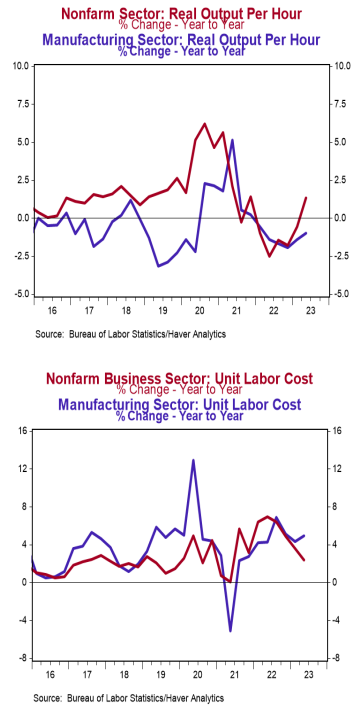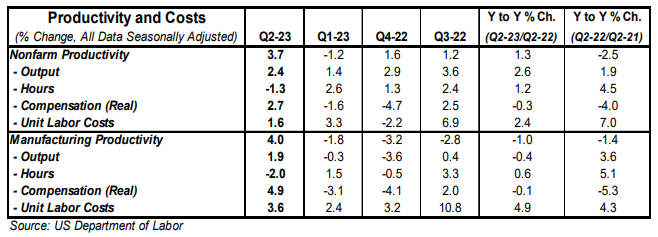- Nonfarm productivity (output per hour) increased 3.7% at an annual rate in the second quarter, easily beating the consensus expected gain of 2.2%. Nonfarm productivity is up 1.3% versus last year.
- Real (inflation-adjusted) compensation per hour in the nonfarm sector rose at a 2.7% annual rate in Q2 but is down 0.3% versus a year ago. Unit labor costs rose at a 1.6% annual rate in Q2 and are up 2.4% versus a year ago.
- In the manufacturing sector, productivity rose at a 4.0% annual rate in Q2. Real compensation per hour increased at a 4.9% annual rate in the manufacturing sector, while unit labor costs rose at a 3.6% annual rate.
Implications:
Nonfarm productivity rose in the second quarter by the most in almost three years, increasing at a 3.7% annualized rate, as output rose while hours worked declined, leading to more output per hour. In spite of the large gain in Q2, productivity – output per hour – is up a modest 1.3% in the past year and up at a similar 1.4% annual rate versus the prior business cycle peak at the end of 2019 (pre-COVID). Even though inflation is still high, “real” (inflation-adjusted) compensation per hour grew at a 2.7% annualized rate in Q2, the first positive reading since the third quarter last year. However, inflation remains a key headwind for workers’ purchasing power as “real” compensation still remains down 0.3% from a year ago. This will be an ongoing issue in the coming quarters, as inflation stays stubbornly high. On the manufacturing front, productivity rose at a 4.0% annualized rate as output increased while hours fell. Much of the manufacturing data we have received over the past few months has shown that manufacturing continues to decelerate. Expect hours and output in this sector to continue to weaken in the quarters ahead. In other news this morning, on the employment front, initial jobless claims rose 6,000 last week to 227,000. Meanwhile, continuing claims increased 21,000 to 1.700 million. Also yesterday, ADP’s measure of private payrolls increased 324,000 in July versus a consensus expected 190,000. These numbers point to continued gains in jobs in tomorrow’s employment report. We’re estimating a nonfarm payroll gain of 220,000 with the unemployment rate remaining at 3.6%. Also earlier this week, cars and light trucks were sold at a 15.7 million annual rate in July, up 0.5% from June and 18.2% from a year ago.





